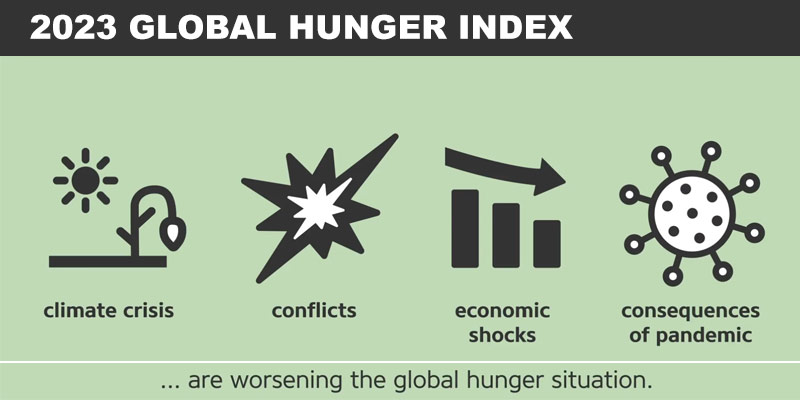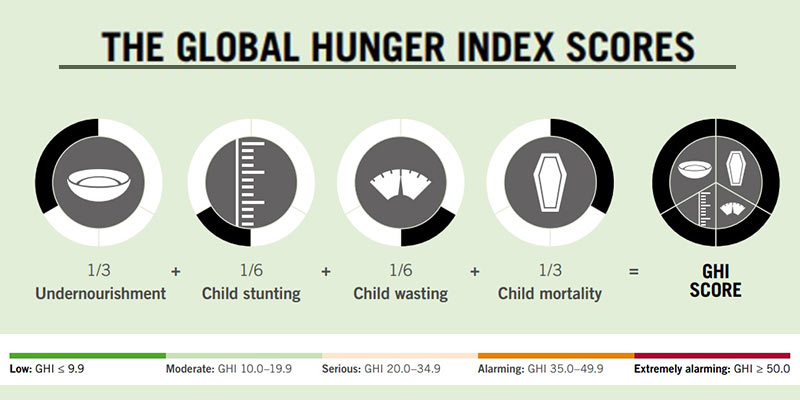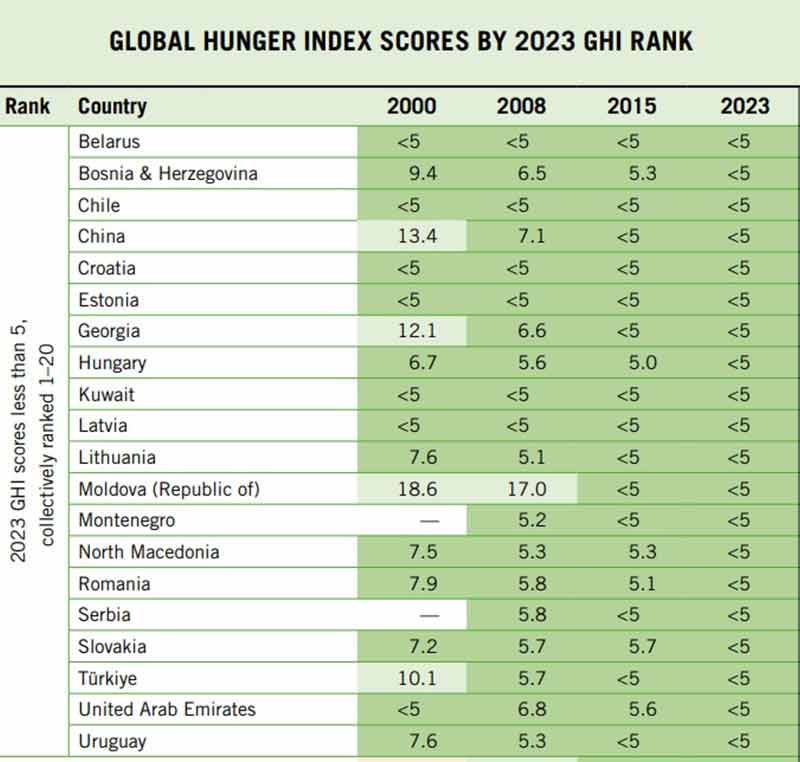- World
- Oct 13
58 countries will not achieve low hunger by 2030
• Global Hunger Index (GHI) 2023 shows that global hunger remains too high, and progress on reducing hunger has largely stalled.
• The 2023 global GHI score is 18.3 — considered moderate — down less than one point from the 2015 global score of 19.1.
• At the current pace, 58 countries will not achieve low hunger by 2030. Projections suggest that none of the GHI indicators will meet the 2030 targets set by the Sustainable Development Goals (SDGs): the prevalence of undernourishment, child stunting, child wasting, and child mortality are all off track.
• The right to adequate food is being violated for nearly three-quarters of a billion people every day.
• There has been an increase in the prevalence of undernourishment, one of the indicators used in the calculation of GHI scores, rising from a low of 7.5 per cent in 2017 to 9.2 per cent in 2022.
• The number of undernourished people in the world increased from 572 million to 735 million in the same period.
• India is ranked 111th out of 125 countries in the Global Hunger Index 2023.
What is Global Hunger Index?
• The Global Hunger Index (GHI) is a tool designed to comprehensively measure and track hunger at global, regional, and national levels, reflecting multiple dimensions of hunger over time.
• It is a peer-reviewed annual report, jointly published by Concern Worldwide and Welthungerhilfe.
• The GHI is intended to raise awareness and understanding of the struggle against hunger, provide a way to compare levels of hunger between countries and regions, and call attention to those areas of the world where hunger levels are highest and where the need for additional efforts to eliminate hunger is greatest.
What is hunger?
Hunger is usually understood to refer to the distress associated with a lack of sufficient calories. The Food and Agriculture Organisation of the United Nations (FAO) defines food deprivation, or undernourishment, as the habitual consumption of too few calories to provide the minimum dietary energy an individual requires to live a healthy and productive life, given that person’s sex, age, stature, and physical activity level.
What is malnutrition?
• Malnutrition refers more broadly to both undernutrition (problems caused by deficiencies) and overnutrition (problems caused by unbalanced diets that involve consuming too many calories in relation to requirements, with or without low intake of micronutrient-rich foods). Overnutrition, resulting in overweight, obesity, and noncommunicable diseases, is increasingly common throughout the world, with implications for human health, government expenditures, and food systems development.
• While overnutrition is an important concern, the GHI focuses specifically on issues relating to undernutrition.
• In GHI, “hunger” refers to the index based on the four component indicators — undernourishment, child stunting, child wasting, and child mortality.
How the GHI is calculated?
Each country’s GHI score is calculated based on a formula that combines four indicators that together capture the multidimensional nature of hunger.
i) Undernourishment: The share of the population whose caloric intake is insufficient.
ii) Child stunting: The share of children under the age of five who have low height for their age, reflecting chronic undernutrition.
iii) Child wasting: The share of children under the age of five who have low weight for their height, reflecting acute undernutrition.
iv) Child mortality: the share of children who die before their fifth birthday, reflecting in part the fatal mix of inadequate nutrition and unhealthy environments.
• The standardised scores are aggregated to calculate the GHI score for each country. Undernourishment and child mortality each contribute one-third of the GHI score, while child stunting and child wasting each contribute one-sixth of the score.
• Calculation results in GHI scores on a 100-point scale, where 0 is the best score (no hunger) and 100 is the worst.
• In practice, neither of these extremes is reached. A value of 100 would signify that a country’s undernourishment, child wasting, child stunting, and child mortality levels each exactly meets the thresholds set slightly above the highest levels observed worldwide in recent decades.
• A value of 0 would mean that a country had no undernourished people in the population, no children younger than five who were wasted or stunted, and no children who died before their fifth birthday.
Nine countries have “alarming” levels of hunger
• According to the 2023 GHI scores and provisional designations, nine countries have alarming levels of hunger and 34 have serious levels of hunger.
• Six countries with 2023 GHI scores in the alarming range are: Central African Republic, Madagascar, Yemen, Democratic Republic of the Congo, Lesotho, and Niger.
• Three additional countries that are provisionally designated as alarming despite insufficient data for the calculation of GHI scores are: Burundi, Somalia, and South Sudan.
• Central African Republic, with a 2023 GHI score of 42.3, has the highest score of any country in this year’s report. The country’s 2020-2022 undernourishment rate of 48.7 per cent means that nearly half of the population is consistently unable to meet minimum dietary energy needs. One in 10 children does not live until their fifth birthday, 40 per cent of children are stunted, and 5.3 per cent of children are wasted. Central African Republic has suffered from conflict in recent years, which, along with population displacement, widespread poverty, and underemployment, drives hunger.
• Madagascar has the second-highest 2023 GHI score in this year’s report, which, at 41, is considered alarming. The third-highest score in the 2023 GHI is held by Yemen, at 39.9.
• South Asia and Africa South of the Sahara are the world regions with the highest hunger levels, with GHI scores of 27 each, indicating serious hunger in both regions.
• Africa South of the Sahara has the highest level of undernourishment of any world region, at 21.7 per cent — a sizable increase compared with 16.8 per cent in 2010-2012. Africa is the one region of the world projected to experience a significant increase in the number of undernourished people, from 282 million in 2022 to an expected 298 million in 2030.
• South Asia’s GHI score and indicator values reflect worrisomely high rates of child undernutrition as well as a substantial level of undernourishment facing the population as a whole. The 2022 child wasting rate of South Asia is 14.8 per cent, the highest of any world region and more than twice the child wasting rate of Africa South of the Sahara of 6 per cent.
• The region with the lowest 2023 GHI score is Europe and Central Asia, whose score of 6.1 is considered low.
Top 20 performers
Countries with GHI scores less than 5 are collectively ranked in the top 20 slots.
These countries are: Belarus, Bosnia & Herzegovina, Chile, China, Croatia, Estonia, Georgia, Hungary, Kuwait, Latvia, Lithuania, Moldova, Montenegro, North Macedonia, Romania, Serbia, Slovakia, Turkey, United Arab Emirates and Uruguay.
Multiple crises affect food security
• The stagnation relative to 2015 largely reflects the combined effects of several crises. These include the COVID-19 pandemic, the Russia-Ukraine war, economic stagnation, the impacts of climate change, and the intractable conflicts facing many countries of the world.
• Their compounding effects have led to a cost of living crisis and exhausted the coping capacity of many countries, especially those where hunger was already high before the crises hit due to power imbalances and structural obstacles to food and nutrition security.
• The global effects of the COVID-19 pandemic, the Russia-Ukraine war, and higher food prices may be easing somewhat in 2023, but climate conditions are worsening and for many people the price of food is still unaffordable in many areas.
• The Russia-Ukraine war contributed to global food price spikes in 2022 and continues to pose a threat to food security. Because of the large quantities of grain and fertilizer produced by Ukraine and Russia, disruptions to supply chains in the region can have significant ripple effects throughout the world, as evident in February 2022, when food prices spiked. The destruction of the Nova Kakhovka dam in Ukraine has highlighted the vulnerability that arises from the world’s dependence on exports from this volatile region.
The way ahead
• The crises the world has faced in recent years have undermined progress toward ending hunger, and the future portends a continuing onslaught of crises for which the world is not prepared.
• Today’s youth not only are affected by the current food crises but also will shoulder the burden of the looming disasters if concerted action is not taken.
• At the global level, endless summits and ambitious declarations have pledged to address hunger and malnutrition and their underlying causes, but if these commitments are never translated into action, the next generation will face increasing levels of food and nutrition insecurity.
• It is more critical than ever to break this inter-generational cycle, and it is increasingly apparent that this will require the holistic transformation of food systems and improvements to governance structures, energy and infrastructure systems, social protection systems, and more, all of which are currently inadequate to achieve Zero Hunger.
• The right to food is violated for millions of people each day, and a robust political commitment to inclusive governance of food systems is needed to ensure this injustice is ended once and for all.
Manorama Yearbook app is now available on Google Play Store and iOS App Store



